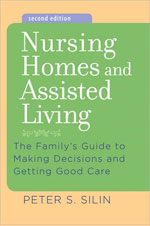Choosing a Nursing Home
From the NYT, Sept 23, 2007 (http://www.nytimes.com/2007/09/23/business/23nursing.html?ex=1348372800&en=e56c0fcfe6d20b5e&ei=5124&partner=permalink&exprod=permalink)
This article tells you why there is another thing you want to look at when you look at nursing homes and other seniors housing--who owns it, and how clear is the corporate structure.In the end, that talks about how much reponsibility they may be willing to accept. And the less they have to accept, the more you might question the quality of care they are providing. Maybe?
Here is the article:
Habana Health Care Center, a 150-bed nursing home in Tampa, Fla., was struggling when a group of large private investment firms purchased it and 48 other nursing homes in 2002.
The facility’s managers quickly cut costs. Within months, the number of clinical registered nurses at the home was half what it had been a year earlier, records collected by the Centers for Medicare and Medicaid Services indicate. Budgets for nursing supplies, resident activities and other services also fell, according to Florida’s Agency for Health Care Administration.
The investors and operators were soon earning millions of dollars a year from their 49 homes.
Residents fared less well. Over three years, 15 at Habana died from what their families contend was negligent care in lawsuits filed in state court. Regulators repeatedly warned the home that staff levels were below mandatory minimums. When regulators visited, they found malfunctioning fire doors, unhygienic kitchens and a resident using a leg brace that was broken.
“They’ve created a hellhole,” said Vivian Hewitt, who sued Habana in 2004 when her mother died after a large bedsore became infected by feces.
Habana is one of thousands of nursing homes across the nation that large Wall Street investment companies have bought or agreed to acquire in recent years.
Those investors include prominent private equity firms like Warburg Pincus and the Carlyle Group, better known for buying companies like Dunkin’ Donuts.
As such investors have acquired nursing homes, they have often reduced costs, increased profits and quickly resold facilities for significant gains.
But by many regulatory benchmarks, residents at those nursing homes are worse off, on average, than they were under previous owners, according to an analysis by The New York Times of data collected by government agencies from 2000 to 2006.
The Times analysis shows that, as at Habana, managers at many other nursing homes acquired by large private investors have cut expenses and staff, sometimes below minimum legal requirements.
Regulators say residents at these homes have suffered. At facilities owned by private investment firms, residents on average have fared more poorly than occupants of other homes in common problems like depression, loss of mobility and loss of ability to dress and bathe themselves, according to data collected by the Centers for Medicare and Medicaid Services.
The typical nursing home acquired by a large investment company before 2006 scored worse than national rates in 12 of 14 indicators that regulators use to track ailments of long-term residents. Those ailments include bedsores and easily preventable infections, as well as the need to be restrained. Before they were acquired by private investors, many of those homes scored at or above national averages in similar measurements.
In the past, residents’ families often responded to such declines in care by suing, and regulators levied heavy fines against nursing home chains where understaffing led to lapses in care.
But private investment companies have made it very difficult for plaintiffs to succeed in court and for regulators to levy chainwide fines by creating complex corporate structures that obscure who controls their nursing homes.
By contrast, publicly owned nursing home chains are essentially required to disclose who controls their facilities in securities filings and other regulatory documents.
The Byzantine structures established at homes owned by private investment firms also make it harder for regulators to know if one company is responsible for multiple centers. And the structures help managers bypass rules that require them to report when they, in effect, pay themselves from programs like Medicare and Medicaid.
Investors in these homes say such structures are common in other businesses and have helped them revive an industry that was on the brink of widespread bankruptcy.
“Lawyers were convincing nursing home residents to sue over almost anything,” said Arnold M. Whitman, a principal with the fund that bought Habana in 2002, Formation Properties I.
Homes were closing because of ballooning litigation costs, he said. So investors like Mr. Whitman created corporate structures that insulated them from costly lawsuits, according to his company.
“We should be recognized for supporting this industry when almost everyone else was running away,” Mr. Whitman said in an interview.
Some families of residents say those structures unjustly protect investors who profit while care declines.
When Mrs. Hewitt sued Habana over her mother’s death, for example, she found that its owners and managers had spread control of Habana among 15 companies and five layers of firms.
As a result, Mrs. Hewitt’s lawyer, like many others confronting privately owned homes, has been unable to establish definitively who was responsible for her mother’s care.
Labels: Nursing Homes




<< Home